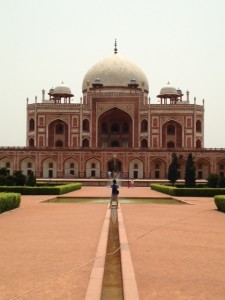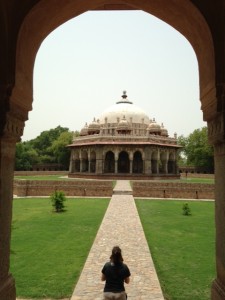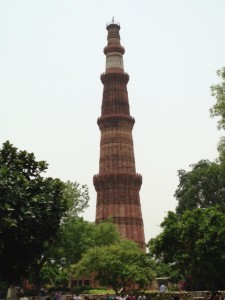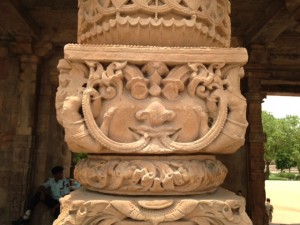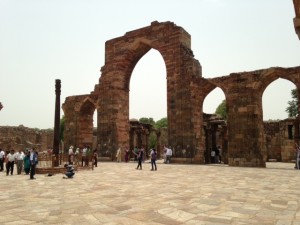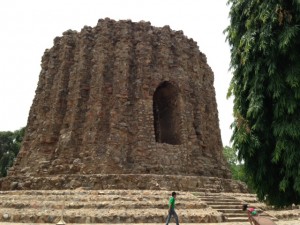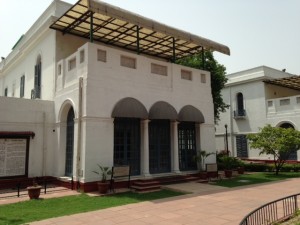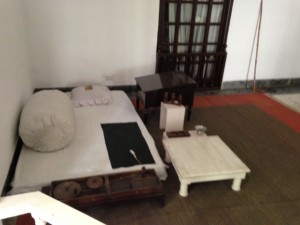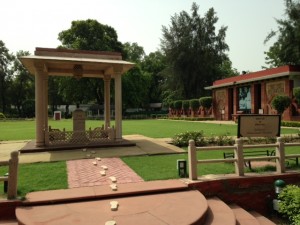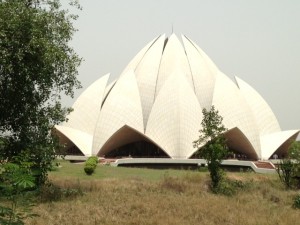Adventures with Ramakat, Part II
Posted on June 23, 2013
Well, the circus has come to town. Or more specifically, Secretary of State Kerry is in the house and the hotel is crowded with security and staff and media people. Every corner of the lobby has some huddle of serious and somewhat hurried staffers poring over documents and schedules. Entry to the hotel requires every car to be searched, mirrors passed underneath under the watchful eyes of gun toting commandos. Inside the hotel US Secret Service in casual clothes (aside from ear pieces, military hair cuts, and those little lapel pins they wear) have been all over and in one case with a German Shepherd in tow. The Indians have their people here too and this is my favorite plain clothes cop:
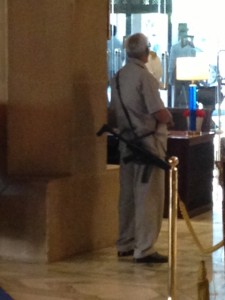
Is it just me or should he either conceal a weapon or just put on a uniform? He seems to be trying to have it both ways. Anyway, we had the first of our meetings and play time is over.
But I did have the earlier part of my Sunday for one more round with my faithful guide Ramakat. We visited the Humayun Tomb, yet another World Heritage Site (something like a third of all such sites sit in India) and the design inspiration for the later Taj Mahal.
Built in 1565 for Emporor Humayun, it is the first of the great Mogul garden tombs with artificial streams and fountains and symmetrical gardens and walkways with great trees offering shade. Desperately needed shade, I might add. In every post I mention the heat and today it was 104. Wow it’s hot and one tramps around these sites in a state of pretty constant sweatiness. The gardens themselves are as attractive as the actual tomb, both inspired by Persian architecture and landscaping, and the interior was ingenuinesly designed to catch every breeze and was noticeably cooler.
Also on the 30 acre site are other tombs and monuments, the most striking being the Tomb of Isa Khan, built in 1547 for an Afghan lord. The whole site had been under threat from shoddy
reconstruction efforts, new mass transit projects, and more, but in more recent years a thoughtful and well funded restoration has taken place and President Obama visited in 2010. It’s a wonderful, peaceful resite from the noie and press of modern Delhi.
The other great World Heritage site we visited today was the Qutab Minar, which goes back to the first Mogul city established when Qutab-al Din defeated the last Hindu king in 1193. The new emperor demolished the Hindu temple at the site and built a mosque and to show just how grand he was, he commissioned a tower of red sandstone and white marble. He lived long enough to only see the first of its five sections built, but his successors kept going up and the final section brought the tower to an imposing 273′ in height.
Think about building a 27-story building with no modern cranes and scaffolds, not to mention power tools. Amazing really. The complex itself is an interesting mix of ruins, some going back to more ancient Hindu times.
When they built their mosque, the new Mogul rulers stacked the carved stones from the previous Hindu site to create mishmash columns.
Wherever the Hindu carvings depicted living forms, the Moguls chipped away the faces as in the stone above. Note the face at the center and the missing heads of the women at the corners. Islam prohibits the depiction of living forms in decorative arts and Ramakat, who I started to suspect might be a Hindu nationalist, was too pleased to point out example after example of Muslims defacing Hindu art.
The other great curiosity on the site is the Iron Pillar (see below) that dates back to before the the 5th C. While iron, it has not rusted in its 2000 years and is a testimony to Hindu metallurgy and whatever alloys they used in its manufacture.
Displaying a Hindu sensibility abut endless cycles of life, Ramakat frequently pointed out the way that every new ruler either built on top of what came before or destroyed the work that came before to build his own legacy. At the site, we visited the start of a minar that was meant to dwarf the Qutab Minar.
But its size was excessive and when that ruler died his successors, baffled at how to build a tower of such breadth and height, just left it in its unfinished early stage. A monument to hubris really.
Needing a little modern India, I asked that we visit the Ghandi musuem and the house where he lived his last months and where he was eventually assassinated by a Hindu Nationalist on January 30th, 1948 just after 5PM.
His rooms were left intact in their simplicity and with his few belongings.
Small stone footprints trace his path to the gardens were he was to lead his followers in prayer and there now stands a small monument on the site where he was shot.
There was a long gallery that in successive panels gave the history of the fight for Indian independence from Britain and eventually Ghandi’s seminal role. I spent a lot of time reading each panel (Ramakat was chafing to get going — he is a guide that sort of likes a quick hit and run approach to these things) and learned a lot about the 1857 Rebellion or Sepoy Mutiny, as the British liked to call it.
Calling it so minimized what was in fact a national rebellion that was widely supported by Indian people, not just rebelling military units, and brutally suppressed by the British military and colonial government. It is a fascinating story and the narrative gave an unvarnished account of the atrocities and widespread violent reaction of a British government that was absolutely shaken at the Indian desire for independence. It was stuff not so different in its inhumaity than what we see reported in Syria today. Ghandi came along in the next century and united people across religious and ethnic lines in a non-violent movement that is of course now widely known and admired and that was the basis for Martin Luther King’s civil rights leadership in our own country.
The museum has on its first floor adoring if outdated exhibits full of wonderful quotes and photos. The second floor had a more interesting contemporary multimedia show called Eternal Ghandi. It gave new digital and multimedia life to classical symbolic objects like spinning wheels, prayer wheels, and prayer beads. It is less of a Ghandi exhibit and more of a tactile expression of Ghandian ideas. For example, there was a digital harp that when touched played Indian freedom songs and three interactive rods evoking prison bars that told accounts of his time imprisoned. Ramakat, a rather literal fellow (we were getting to really know each other by this point), said it was an exhibit designed for children. I didn’t try to correct him.
However, when we were next on our way to the Lotus Temple, the Baha’i interfaith temple built in 1986 and now hugely popular among Indians (the line to get in stretched far down the road, despite the fact that there is little actually inside), I finally got a Ramakat question right. He explained that there are seven great Baha’i temples equalling the number of continents.
Ramakat: Can you tell me what continent does not have a temple, sir?
Me: (thinking this one was pretty darn obvious) Antarctica, Ramakat.
A look of disappointment washed over his face such that I wished I had answered Africa or something wrong. He was rendered silent for a moment. Equilibrium was restored when he asked me if I knew what the temple contained (answer: nothing). I admitted that I could not muster a guess and Ramakat happily said nothing (sort of a trick question if you ask me). Seeing the lines to get in and knowing the attraction was the exterior of the building,
I agreed that we could just stop to take a look from outside the compound. This suited Ramakat’s previously mentioned quick hit approach to tourism and with that I was fully restored to his good graces.
With a desperate need for A) water, B) a shower, and C) air conditioning, we made our way back to the hotel and thus ended my play time in Delhi. Here ends the historical dispatches, but I will follow with the even more fun topics of people and food. I’ve already had wonderful interactions with both, but off to a meeting with Under Secretary Kanter and two successful Indians entreprenuers now trying to create a radically new K-12 school.
